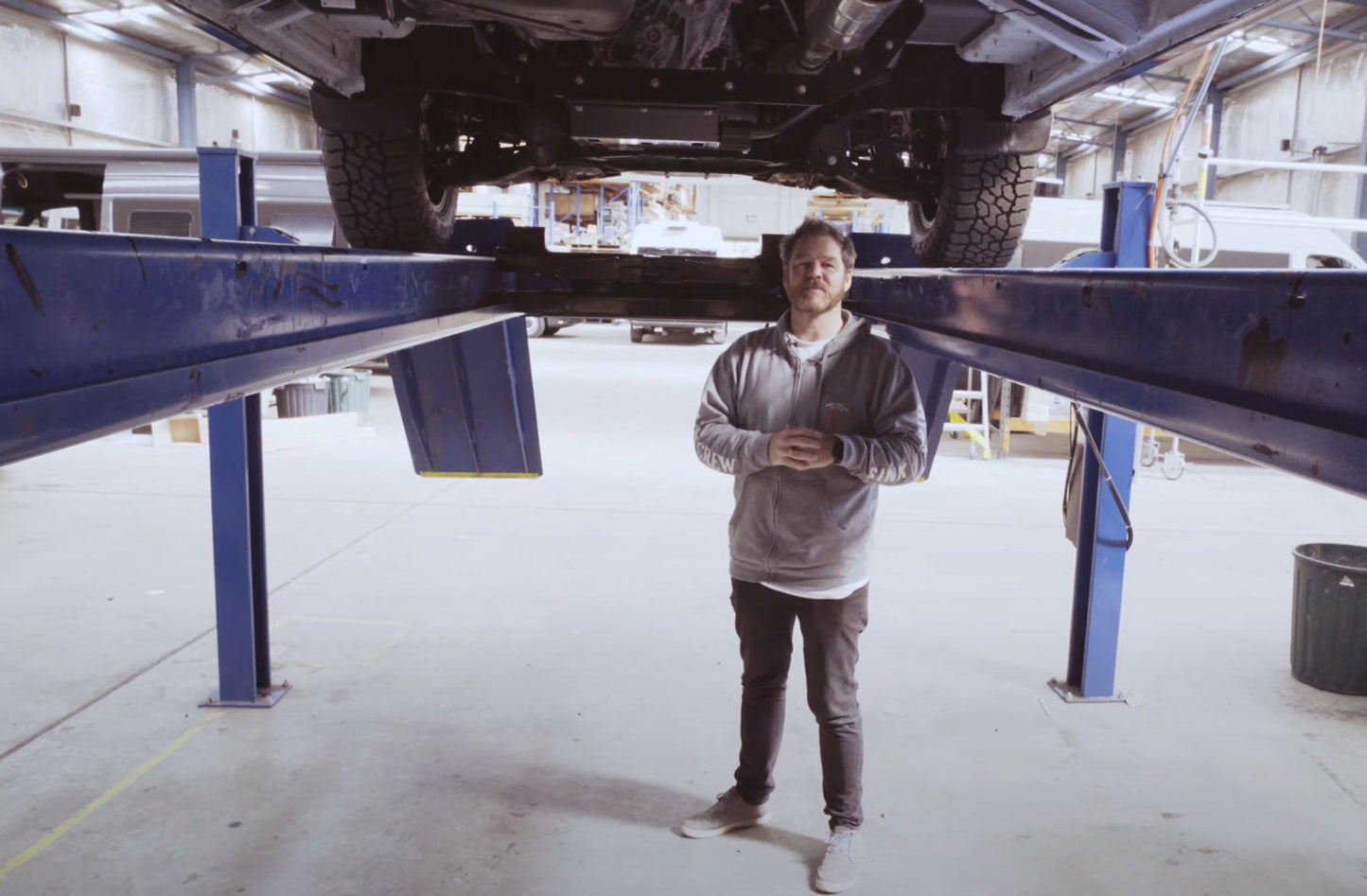
Dominic Wiseman has been covering all things TRAKKA for half a decade now. He's covered everything from our Trakkadu pop top campervan, Akunas and Jabirus both in mid and long wheel base, 2WD and off road. He's camped in, slept in, cooked in, driven them and been behind the scenes and under vehicles on a hoist in the factory. Beyond just TRAKKA, he has years experience writing for various automotive and 4x4 publications so we asked him for some further things to consider when choosing the right camper.

The choice between a 2WD (two-wheel drive) and a 4WD (four-wheel drive) vehicle can make a significant difference in the places you can reach. Each option has its own advantages and limitations, so understanding the places you wish to reach is crucial before embarking on your next trip.
Typically. 2WD vehicles are lighter and more fuel-efficient compared to its 4WD equivalent. 2WD are a great choice for driving on tar all the way to reasonably well-maintained gravel roads. They offer a smooth and comfortable ride for everyday use. Due to having drive effectively going to only two wheels, a 2WD vehicle could struggle in challenging off-road terrains, such as steep inclines, muddy trails, or loose surfaces. This type of terrain is best suited to a 4WD.
Luckily Australia is blessed with locations that are accessible, and still relatively out of the way, for us to explore. Most of the popular east coast destinations are easily accessible in a 2WD campervan. Tasmania is a classic example where you can regularly find out of the way places without needing off road capability. Want to hit the Big Red Bash for instance? Strap in the family and hit the road. You do not need off the road tracks to visit Uluru-Kata Tjuta National Park. What will be out of reach, for instance, is crossing the Simpson Desert or travelling the tracks in the Victorian high country during winter and period of heavy rainfall.
A 4WD vehicle is designed to conquer rugged terrains and tackle various off-road obstacles. Power is delivered to all four wheels, providing enhanced traction and stability. The added versatility of 4WD systems, such as differential locks, empowers you to conquer more challenging landscapes such as muddy slopes, wash outs where the road has eroded away and rocky or sandy beaches.
While a 2WD vehicle is suitable for everyday driving and exploring the easy-to-access locations with a healthy mix of dirt road/good quality track driving thrown in, a 4WD vehicle provides the necessary capability to reach more remote and challenging off-road destinations.
On-road, a 2WD vehicle offers several advantages over a 4WD vehicle. Primarily is improved fuel efficiency. 2WDrives have fewer drivetrain components to power, they also tend to be lighter, resulting in better fuel economy compared to a 4WD vehicle. This can save you money at the pump, especially during long highway drives and allows you to travel farther for less.
The other consideration is 2WD vehicles typically have a lower purchase price compared to their 4WD counterparts. The absence of complex 4WD systems and components reduces manufacturing and maintenance costs, making 2WD vehicles more affordable for budget-conscious drivers.
More simply, 2WD vehicles often provide a smoother and more comfortable ride on tarred roads. There is no transfer case or front differential which results in reduced mechanical complexity and leads to improved handling and maneuverability.
Overall, if your primary focus is majority of on-road driving, a 2WD vehicle offers better fuel efficiency, a more affordable price tag, and enhanced ride comfort. However, it's important to consider your specific needs and driving conditions before deciding.
There are conditions that require caution and attention to ensure a safe and smooth ride in a two 2WD.
Slippery Surfaces. These can be wet roads, icy patches, or oil spills, slippery surfaces can reduce traction and increase the risk of skidding or losing control. With only 2 wheels being driven, traction is the biggest concern. If you encounter conditions like the above, drive cautiously, reduce speed, and maintain a safe following distance to account for the decreased grip.
Off-Road or extreme dirt roads. 2WD vehicles may face limitations when encountering off-road or conditions such as muddy trails, loose gravel, or uneven surfaces. Again, the reduced traction and sometimes ground clearance can make it challenging to navigate through these conditions, increasing the risk of getting stuck or damaging the vehicle.
Steep Inclines. Climbing steep hills or inclines with slippery surfaces can be challenging for 2WD vehicles, especially if it is a heavy camper van. You can suffer from loss of traction or wheel spin. The best thing to do is approach inclines with caution and maintain a steady speed to avoid wheel spin or rolling backward.
Sometimes less relevant to camper vans are heavy Loads or towing. Carrying heavy loads and towing can affect vehicle weight distribution and stability. Always ensure your vehicle is within its load-carrying capacity and that the load is properly secured and distributed properly to maintain control.
Most conditions will be up to the vehicle operator. It is imperative as the operator you are aware of the vehicle’s capabilities and limits. In almost all situations, slow and steady is the best option. This will ensure you aren’t so committed that you cannot get out of any situation plus it will reduce the likelihood of vehicle damage.
Most vehicles are capable of much more than we throw at them. I would even happily take a 2WD vehicle down a gravel or dirt road as long as I did it carefully and having driven the vehicle before. Until you start to experience really steep inclines, declines, or rutted roads most will handle the odd mission down a dirt road to find a sweet camping spot.
There are of course places that a 2WD should not be and the beach is one. They simply do not have the traction/drive, nor clearance required, so unless you plan on being rescued, stay off the beaches.
Some tracks are not suitable for 2WD or 4WD vehicles. Campervans with their higher centre of gravity probably should not be on a track that looks like a scene out of Mad Max Fury Road. Steep sandhills traversed sideways, or hugely lopsided tracks could cause the van to tip onto its side. Neither 2WD, nor 4WD will help you here.
Then as a bit of a comparison - gnarly spots for 4WD access (Crafter/Sprinter size)
In Australia, there are several regions and terrains where driving a two-wheel drive (2WD) vehicle is not recommended due to the challenging conditions. Here are a few examples:
Outback and Very Remote Areas: Australia's vast outback and remote regions often feature rough, unpaved roads, sandy tracks, and unpredictable terrain. The lack of infrastructure and long distances between services make these areas more suitable for four-wheel drive (4WD) vehicles, which offer better traction, ground clearance, and off-road capabilities.
Beaches and Sand Dunes: Australia's stunning coastal regions often tempt drivers to venture onto sandy beaches and sand dunes. However, soft sand can be treacherous for 2WD vehicles, as they are more prone to getting stuck. Driving on beaches and sand dunes is generally reserved for 4WD vehicles equipped with appropriate tires and sand-driving techniques.
High Country and Alpine Areas: Australia's alpine regions, such as the Snowy Mountains, may experience snowy, icy, or muddy conditions during colder months. Navigating these areas safely requires the stability and traction control offered by 4WD vehicles, especially when encountering steep inclines or slippery surfaces.
Remote National Parks and Reserves: Australia is home to diverse national parks and reserves with rugged terrains, river crossings, and rocky trails. Some of these areas have restricted access only, ensuring the preservation of delicate ecosystems and preventing damage to sensitive habitats.
It's essential to consider the specific driving conditions, terrain, and weather when planning a trip in Australia.


